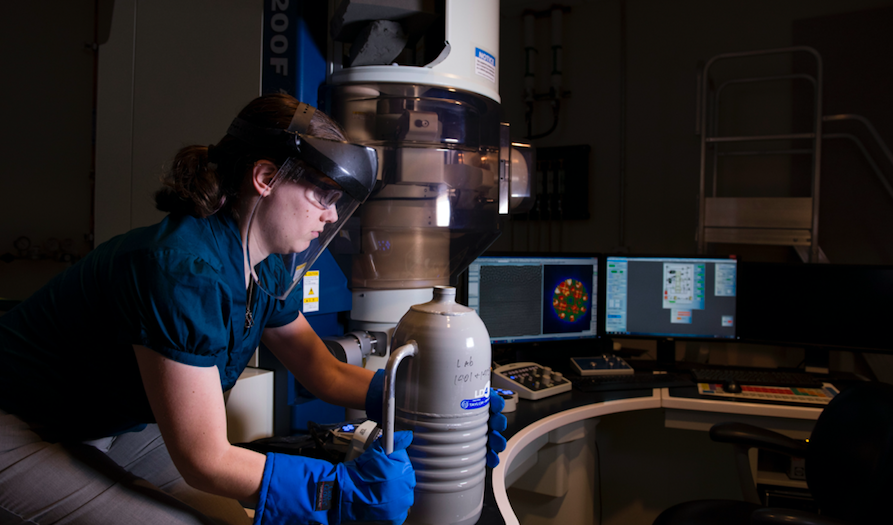Maria Violaris
Why can’t you plug your computer into your bathtub? It seems like an obviously bad idea but, as Maria Violaris (4th year physicist) points out, when you zoom right in you’re surrounded by fast moving particles buzzing with energy. If we could find a way to harness this energy it begins to seem like not such a bad idea after all. So why then can’t you utilise this energy?
The answer lies at the border of physics and chemistry with the second law of thermodynamics which states “the total entropy of an isolated system cannot decrease”, where entropy is a measure of disorder of the universe. Converting heat energy from the bath to power an electrical device would mean a net loss in entropy, which is not strictly possible.
Violaris goes on to consider some “demons” that may deceive us into believing that we can squeeze out the energy from our bath after all. These are quite difficult thermodynamic concepts to comprehend but, with the help of a balloon and an inflator nozzle (where air can go in but doesn’t escape), Violaris can explain. She first introduces us to “Smoluchowski’s demon”. The spontaneous inflation of a balloon through a one-way valve by the moving particles in a hot bathtub would be very similar to the energy exchange we would need to power a PC from a bath. However, to achieve this ease of opening, the flap would have to be so light that it would be under the influence of the same random movement as the particles meaning it is unable to function as a one way flap. The second law is safe and the demon defeated. Unless…
What if I had a way to know when to open and close the flap? suggests Violaris. If I could store information about the particles and only open it when they’re heading in the right direction would this break that law and lead to the conversion of energy? Here we have “Maxwell’s demon” but it too is not invincible. We can only store a finite amount of information, so if we kept filling balloons this way, we would eventually need to start erasing our information about particles. This must increase the entropy of the environment by ‘Landauer’s Principle’. Take that Maxwell’s demon! The second law is restored.
There is, however, a potential solution to power this computer – but it does involve a foray into the madness of quantum mechanics. Violaris introduces us to the “quantum deity” – so called as it has the potential to solve this problem without breaking the second law. Given a bath of “entangled” particles, the “quantum deity” can convert heat energy from our bath into “work” while maintaining entropy by destroying their “entanglement.”
As with many quantum properties (ones only observed on a tiny, tiny scale) entanglement is not quite the same as its classical definition. The entanglement described by Violaris is an unusual property of particles occurring when two or more of them interact in a way that means there is more information in the combined state of the particles than if they are measured individually. This reduces their freedom, thus the system has low entropy. When entangled particles are disentangled, their entropy is increased. So if we could get our bath of entangled particles and disentangle them, we could convert their kinetic energy to work but by increasing their freedom, conserve entropy. This may have an interesting application in the efficiency of quantum computers, which rely on producing entangled particles, many of which remain unused.
While there are many hurdles to overcome (not least working out how we can disentangle these miniscule particles) the prospect is very exciting. I look forward to the day I don’t have to panic about the lack of plug sockets in the bathroom and charge my quantum computer straight from my entangled tub.
Naomi Mburu
Naomi Mburu (DPhil student in engineering) starts her talk by asking us to look to the sky, not as ourselves, but as 19th century scientists wondering what in the world powers that big ol’ burning thing in the sky, our Sun. Back then your mind would have leapt to coal but we now know that if that was the case, the Sun would have burned out billions of years ago. To recreate that kind of power on Earth we don’t need an impossibly big lump of coal but something very tiny instead – atomic nuclei. A nuclear fusion reactor contains a hot plasma of atoms, whose nuclei are forced together with such power that they fuse and release huge amounts of energy.
Nuclear fusion, Mburu explains, if we got it to work would be the solution to the world’s energy problems, producing 15 million times as much energy per gram as burning coal does. Unfortunately, producing a star on Earth is incredibly difficult, which isn’t really a surprise considering even a medium-sized star like the Sun could fit a million Earths inside.
To crack the problem, engineers like Mburu have to find conditions which will give a value of Lawson’s triple product (three factors which control the ability of nuclei to fuse) of 1028, a pretty big number. The three components of the triple product are particle density, temperature (which must be 10 times greater than that of the Sun) and confinement time (how long the atoms are held at this density and temperature). It’s the second of these three factors that is the focus of Mburu’s work, mainly what kind of material can withstand temperatures of this kind.
With a temperature 10 times the temperature of the Sun needed at the centre of the plasma, this means the walls of any fusion reactor container need to be able to withstand temperatures of around 2000 Kelvin. This is a temperature at which most metals melt or become brittle and easily breakable. Finding materials that will work at this temperature is no easy task and described by Mburu as a bit of a chicken and egg situation. To find a material to withstand these temperatures we need a fusion reactor to test it in. To build such a fusion reactor we need to know what materials can withstand these temperatures.
One possible solution, Mburu explains, could come from lining the insides of our reactors with liquid metals to protect the solid walls. The current fusion reactor technology (tokamak) maximises the particle density part of the triple product with control by a large magnetic field. Liquid metals tend to be very conductive and have many free electrons which could interact with a magnetic field to hold the liquid on the roof and sides of a reactor.
This solution still leaves many questions to be answered. Problems quickly arise when you start to consider how to switch on and off the reactor’s magnetic field without having your liquid walls collapse into your hot plasma. There’s also the issue of “quenching.” The walls would burn you to a crisp but are very cool compared to the heart of the reactor. If the plasma touches the wall it will immediately transfer its heat and no longer be hot enough for fusion to occur.
So, the problem of the fusion reactor now becomes a truly interdisciplinary puzzle. While engineers like Mburu work on the walls with materials scientists, theoretical physicists and computer scientists are teaming up to model plasmas that won’t stray too far and get quenched by their container. Pool together all of their great ideas and we may just get the Sun on Earth.





